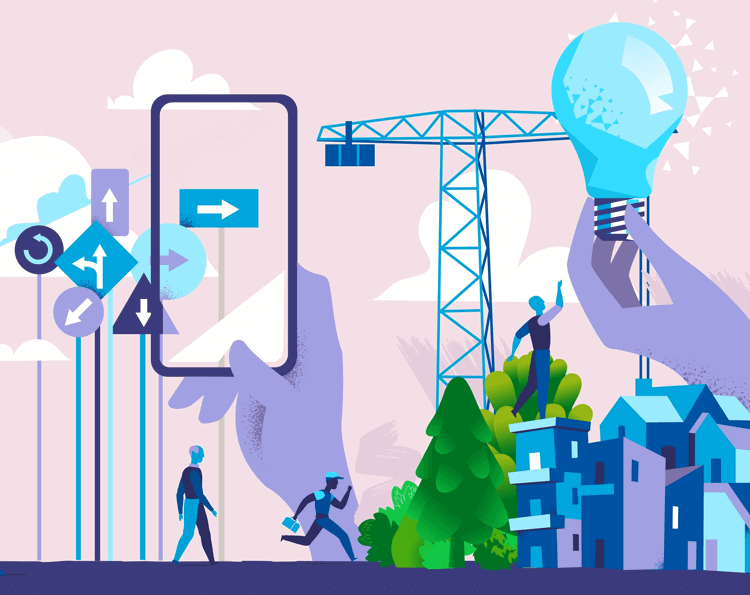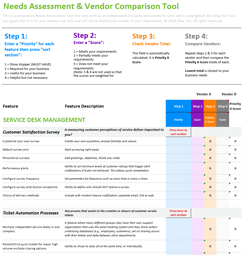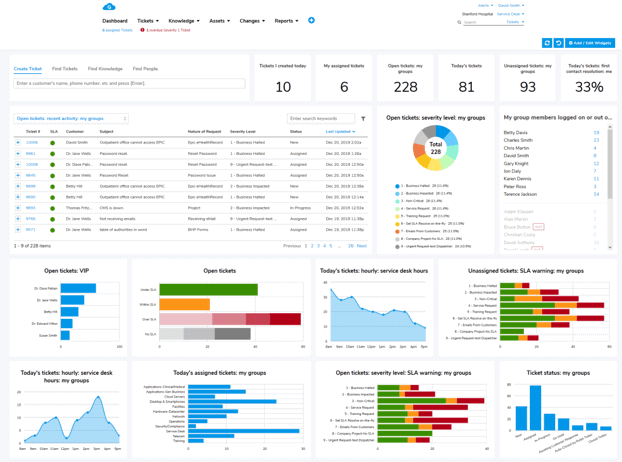What Is IT Service Delivery? Key Aspects Plus Benefits, Challenges and Trends
IT service delivery is often behind the scenes, but it's one of the most important parts of keeping a business running smoothly. It's how IT teams manage requests, resolve issues, roll out updates, and support the tools and systems everyone relies on day to day.
When it's done well, people hardly notice — everything just works. But when it breaks down, the ripple effects can slow teams down, frustrate users, and cost the business time and money.
In this guide, we'll examine what service delivery in IT really means, why it matters, and how to improve it in practical, measurable ways.

Beyond the Basics: Core Pillars of IT Service Delivery
Strong IT service delivery relies on more than just solving issues as they come up. It's built on a foundation of core practices that keep services consistent, efficient, and aligned with business needs at all times. Here are the pillars that make it all work:
-
Service Desk Management
The service desk is the front line of IT. It's where users go when they need help, and how issues get tracked, prioritized, and resolved. A responsive, well-organized service desk can boost productivity and reduce downtime across the company.
Read more on Service Desk Management from our ITIL Resource Center.
-
Incident and Problem Management
Incidents are unplanned disruptions — like a login issue or a system crash. Problem management looks deeper, identifying the root causes behind recurring incidents. Together, these processes reduce chaos and create long-term stability.
Read more on Incident Management and Problem Management.
-
Change Management
Rolling out new tech or updating existing systems requires careful coordination. Change management ensures changes are tested, communicated, and implemented without disrupting the business. It's all about balancing speed with control.
-
Configuration and Asset Management
Knowing what IT assets you have, where they're located, and how they're configured is key to managing risk and planning upgrades. This pillar keeps your tech environment organized and traceable.
Read more on Service Configuration Management and Asset Management.
-
Service Level Management (SLM)
Service Level Agreements (SLAs) set clear expectations between IT and the business. On the other hand, SLM tracks how well IT meets those expectations. This helps teams stay accountable and continuously improve.
Read more on Service Level Management.
Why It Matters: The Top Benefits of Effective IT Service Delivery
When IT service delivery works well, most people don't think twice about it. But behind the scenes, a well-oiled service delivery process brings major benefits, both for IT teams and the business as a whole.
-
Faster Issue Resolution
A clear, structured service delivery approach makes it easier to identify and fix issues quickly. Whether it's a password reset or a system-wide outage, faster response times mean less downtime and happier users.
-
Better End-User Experience
When employees know where to go for help, and consistently get the support they need, it builds trust in IT. A reliable experience across service channels improves satisfaction and boosts productivity.
-
Stronger Alignment Between IT and the Business
Good service delivery isn't just about fixing tech, it's also about supporting strategic goals. By tracking the right metrics and responding to real business needs, IT becomes a true partner, not just a support team.
For example, an IT team that prioritizes uptime for a customer portal during peak sales periods isn't just maintaining systems, they're directly supporting revenue goals.
-
Scalability and Consistency
As companies grow, so do their IT needs. A mature service delivery framework helps maintain consistency across teams, locations, and systems, without reinventing the wheel every time something changes.
For example, an IT team with automated ticket routing, self-service portals, and knowledge bases in place can handle a higher volume of support requests as the company adds more employees. All of this, without needing to dramatically increase headcount.
-
Reduced Risk and Better Compliance
Structured processes around things like change management, access control, and asset tracking help reduce operational risk and ensure compliance with internal policies and external regulations.
When Things Go Sideways: Common Challenges in IT Service Delivery
Even with the right tools and processes, IT service delivery isn't always smooth sailing. Teams often run into roadblocks that slow down progress, frustrate users, and create gaps between IT and the rest of the business. Here are some of the most common challenges and what they look like in practice.
-
Siloed Teams and Disconnected Tools
When different IT functions (like support, infrastructure, and security) use separate systems that don't communicate, service delivery becomes fragmented.
Example: A support team logs a recurring issue, but the infrastructure team isn't notified. This leads to repeated tickets and wasted time troubleshooting the same problem over and over again. This creates frustration, not just for internal teams, but potentially even customers as well.
-
Misaligned Expectations
If IT and the business aren't on the same page about what success looks like, frustration builds. Service Level Agreements may exist, but without shared understanding, they don't always reflect what's actually important.
Example: An SLA promises a 24-hour response time to in-person company service requests, but the sales team needs laptop setups within 4 hours, same-day, during onboarding season. Without alignment or flexibility, both sides feel let down.
-
Reactive, Not Proactive
Too often, IT teams are stuck firefighting — solving problems as they arise rather than preventing them in the first place.
Example: An IT help desk associate resolves printer issues daily, but no one investigates the outdated driver causing the failures — so the tickets just keep coming. Look ahead and keep track of the latest in technology. These trends could be indicators that your current tech set-up is aging and getting close to a state where issues could start to arise more frequently.
Learn more from our blog post Proactive IT Fully Explained: What It Is & 15 Top How To's.
-
Metrics That Don't Tell the Whole Story
Tracking the wrong KPIs can give a false sense of success. Just because tickets are closed quickly doesn't mean the experience is improving.
Example: A service desk team celebrates resolving most tickets in under 10 minutes. But internal surveys show users are still frustrated, because those quick fixes don't solve the root cause. Closing tickets fast doesn't always mean solving the problem permanently.
-
Resistance to Change
Even well-intended improvements can run into pushback if they feel disruptive or overly complex.
Example: A company introduces a new ITSM tool to streamline service requests, but the interface is clunky and training was rushed. Support staff revert to email and spreadsheets, undermining the system before it has a chance to succeed.
Spotting these issues early, and knowing what to do next, can be the difference between surviving and scaling. In the next section, we'll look at where service delivery is headed and how forward-thinking teams are staying ahead.
The Cutting Edge: 2025 Trends in IT Service Delivery
The way businesses deliver IT services is evolving fast. In 2025, the focus isn't just on keeping systems running. It's about improving the user experience, making smarter decisions with data, and building scalable, resilient service models. Here are the trends leading the charge this year:
-
AI and Automation Are Moving from Buzzwords to Baseline
AI-powered tools are now handling more than just ticket triage. They're also suggesting solutions, automating responses, and even predicting incidents before they occur.
Think of virtual agents that solve common issues instantly or backend automations that escalate critical tickets based on user sentiment, not just severity tags.
-
Shift-Left Strategies Are Becoming the Norm
Teams are pushing support closer to the end user (based on Shift-Left concepts) through self-service portals, knowledge bases, and chatbots. This means issues are resolved before they ever hit the help desk.
This doesn't just improve efficiency; it also frees up IT staff to focus on more strategic work instead of repetitive tasks.
-
Experience Level Agreements (XLAs) Are Gaining Traction
More organizations are moving beyond traditional SLAs and looking at how users actually feel about IT services. XLAs measure things like satisfaction, ease of access, and perceived value. These are designed to offer a more complete view of service quality.
This shift encourages IT teams to design services around people, not just processes.
-
Hyperautomation is Simplifying Complex Processes
By linking together multiple systems, workflows, and decision points, hyperautomation reduces manual steps across the IT service delivery chain.
For example, onboarding a new employee can trigger automated account provisioning, hardware assignments, and compliance checks, all without human input.
-
ESG and Sustainability Are Entering the IT Conversation
IT departments are increasingly being asked to align with Environmental, Social, and Governance (ESG) goals.
This includes reducing energy consumption in data centers, responsibly recycling hardware, and building inclusive service experiences that meet accessibility standards.
These trends aren't just "nice to have." They have instead become baseline for IT organizations looking to stay efficient, user-focused, and future-ready. Up next, we'll explore how to put these ideas into practice.
Read even more about the latest ITSM trends.
How to Deliver: Giva's Practical Framework for IT Service Excellence
Delivering top-tier IT service delivery requires purpose-built tools. Giva's cloud-based ITSM platform offers the workflows, visibility, and usability that modern IT teams need, based entirely on real product capabilities.
Here's how Giva helps teams deliver excellence:
-
Define Clear, Measurable Outcomes
Giva offers real-time dashboards, grids, and charts that let you track performance metrics like SLA compliance, ticket volume, technician response times, and customer satisfaction, all configurable via its Easy Three Click Reporting™.
-
Standardize with Intuitive Workflows
The platform includes out-of-the-box ITIL-aligned templates for incident, problem, change, and service catalog workflows. Action and routing rules, plus parent/child ticket relationships ensure consistent process handling across teams.
-
Prioritize Usability for Both Users and Agents
Giva's clean interface is designed for ease of use. It provides self-service portals with AI-powered ticket and knowledge Copilots, macros/quick incidents, and robust search. This enables users and agents to resolve tickets faster and with less friction.
-
Drive Decisions with Data
Comprehensive reporting and analytics tools allow you to detect trends, schedule automated reports, and run satisfaction surveys. Visual data supports proactive analysis and continuous process improvement.
-
Scale Effortlessly with a Cloud-Native Platform
Giva is a 100% cloud-based SaaS solution with fast setup (often in hours), no coding required, and seamless updates. It supports multiple service desks and mailboxes for multi-team scalability.
-
Deliver Secure, High-Availability Service
Built with enterprise-grade security standards, Giva includes HIPAA compliance, encrypted data backup, multi-factor authentication, and continuous cloud redundancy — all managed without infrastructure overhead.
Want to see what streamlined, user-friendly IT service delivery actually feels like? Giva's cloud-based ITSM platform is fast to set up, easy to use, and powerful enough to support your most important service workflows.
Learn more by getting a demo to see Giva in action, or by starting your own free 30-day trial.
The Wrap-Up: Why IT Service Delivery Is Business Delivery
IT service delivery isn't just about keeping systems online. It's about keeping the business moving. From onboarding employees to resolving everyday issues, the quality of IT services affects how people work, how teams collaborate, and how goals are met.
As we mentioned earlier, when service delivery works well, most people don't even notice. But that quiet reliability is exactly what makes it so powerful. It's not just an IT concern, it's a foundation for business success.
Explore Related Resources to Learn More
- Learn the ITIL Change Management Process Fully: Complete Guide
- Help Desk vs Service Desk vs ITSM: What Are the Differences?
- Top 15 Benefits of ITSM Plus How-To Tips
- 10 ITSM Trends for 2025: How to Streamline Your Operations
Next Steps: Ready to Transform Your IT Service Delivery?
If you're looking to modernize your IT service delivery, the most important step is to choose tools and processes that make life easier for both users and IT teams. Giva's cloud-based IT Service Management software is designed to help you do just that.
Here's how you can get started:
Schedule a demo or start a free 30-day trial of Giva's ITSM platform. No credit card required, fast setup, and nothing to install.





